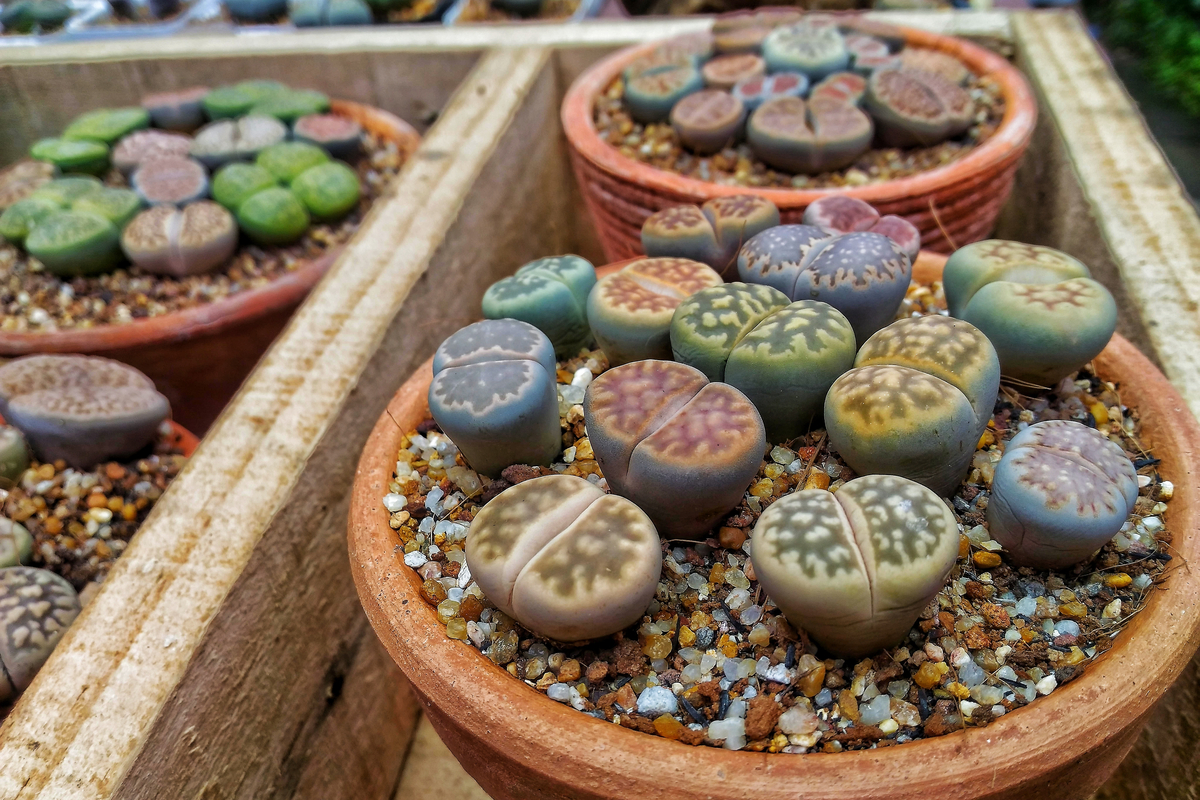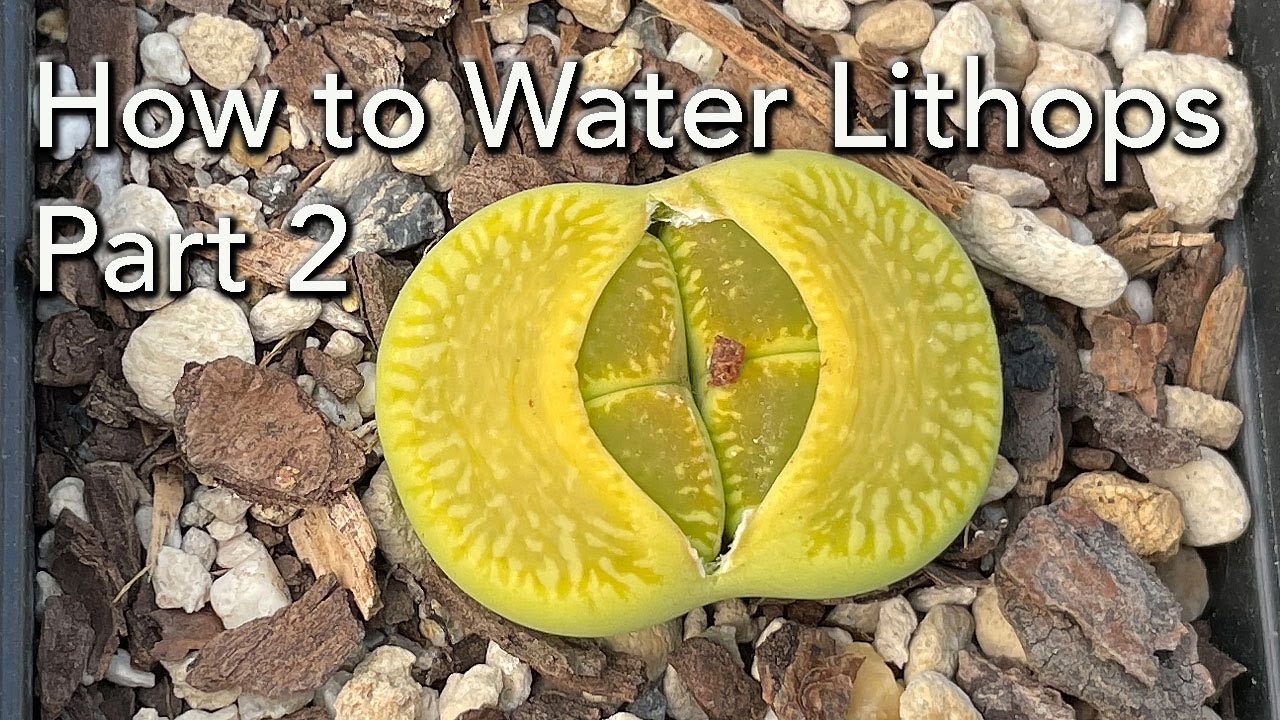To water lithops, wait until the soil is completely dry and then thoroughly soak the plant until excess water drains out. Lithops, commonly known as living stones, are unique succulents that have adapted to survive in arid environments.
These fascinating plants have evolved to resemble rocks, which helps them blend in with their natural surroundings and avoid being consumed by animals. Due to their adaptation to dry conditions, lithops have specific watering requirements. Overwatering can cause the plant to rot, while underwatering can lead to dehydration.
In this guide, we will discuss the best practices for watering lithops and how to keep them healthy and thriving. By understanding the unique watering needs of lithops, you can ensure they thrive in your garden or indoor space.

Credit: www.happysprout.com
Understanding Lithops Watering Requirements
Lithops, also known as “living stones,” have unique watering needs that must be understood. These fascinating succulents have adapted to survive in their arid native habitats, and replicating those conditions is crucial. Lithops require infrequent watering to prevent rotting caused by overhydration.
It is best to water thoroughly but sparingly, allowing the soil to completely dry out between watering sessions. During the active growing season in spring and fall, provide more water, but still maintain the dry-dry cycle. Avoid watering during the summer and winter dormant periods.
Choosing the right soil mix that promotes good drainage is essential as well. Remember not to water Lithops when their exterior leaves appear shriveled, as this is a natural adaptive response. Establishing a watering routine that mimics their natural environment will help your Lithops thrive.
Signs Of Underwatering Lithops
Detecting dehydration in Lithops is crucial for their survival. One indication of underwatering is wrinkled and shriveled leaves. Another sign is a lack of new growth and stunted development. If you notice the leaves turning yellow or brown, it could be a sign of prolonged underwatering.
Additionally, an underwatered Lithops may feel soft and squishy to the touch instead of firm and taut. To avoid this issue, make sure to water your Lithops sparingly but consistently, providing enough moisture to keep the soil slightly moist. Remember to also take into account the environmental conditions, such as temperature and humidity, as they can affect water requirements.
By recognizing the symptoms of underwatered Lithops, you can adjust your watering routine accordingly and promote healthy growth for these fascinating succulents.
Signs Of Overwatering Lithops
Lithops, also known as living stones, require careful watering to thrive. Overwatering can spell disaster for these unique succulents. To identify if you’re overwatering your lithops, watch out for certain signs. These symptoms include soft and mushy leaves, yellowing or transparent appearance, and an overall droopy appearance.
When lithops are waterlogged, their roots can rot, leading to irreversible damage. To prevent overwatering, it’s essential to understand the water needs of lithops. They are drought-tolerant plants and require very little water. It’s best to water lithops sparingly and only when the soil is completely dry.
This will mimic their natural habitat and ensure their survival. By recognizing the signs of overwatering and adjusting your watering habits accordingly, you can help your lithops thrive and flourish.
Best Practices For Watering Lithops
Watering lithops can be a bit tricky, but with the right approach, you can keep them healthy and hydrated. The key is to be mindful of their water needs. Lithops are succulent plants, so they store water in their leaves.
It’s important not to overwater them, as this can lead to root rot. Instead, water them sparingly, only when the soil is completely dry. When watering, make sure to use a gentle spray or a watering can with a narrow spout to avoid getting water on the leaves.
It’s also best to water them in the mornings, allowing any excess water to evaporate throughout the day. By following these best practices for watering lithops, you can help them thrive and enjoy their unique beauty.
How to Water Lithops: Step by Step Guide
Choosing The Right Watering Method
Watering lithops plants is a crucial part of their care routine. To ensure their well-being, you need to choose the right watering method. Two popular approaches for lithops are drip irrigation and soaking. Drip irrigation involves slowly providing water directly to the base of the plant, mimicking natural rainfall.
This method helps prevent water from sitting on the plant’s surface, reducing the risk of rot. On the other hand, soaking involves submerging the plant in water for a short period. This method allows the lithops to absorb water from both its roots and the surrounding soil.
However, it’s important to note that lithops are desert plants and are adapted to survive in harsh conditions. Therefore, it is crucial to avoid overwatering and allow the soil to dry out fully before watering again. By selecting the appropriate watering method, you can help your lithops thrive.
Watering Frequency For Lithops
Watering lithops is a crucial task, and getting the frequency right is essential for their well-being. Lithops, also known as “living stones,” are succulent plants that store water in their leaves. To determine the optimal schedule for watering lithops, you need to consider various factors.
First, observe the appearance of your lithops; their leaves should be plump and firm. If they appear wrinkled or shrunken, it’s a sign they need water. Additionally, take note of the season and temperature. Lithops go through a dormant period, requiring less water.
During active growth, water them sparingly every two to three weeks. It is vital to use well-draining soil and water them thoroughly but never allow water to sit in the tray for extended periods. By following these guidelines, you can ensure your lithops thrive and stay healthy.
Determining The Ideal Watering Season
Determining the ideal watering season for lithops is crucial for their healthy growth. By understanding the best seasonal schedule for watering these unique plants, you can ensure their survival and longevity. Lithops require a well-defined watering routine that takes into account their specific needs.
During the active growth period, which typically occurs in autumn and spring, it is essential to provide regular watering. However, during the dormant period, which usually takes place in summer and winter, watering should be minimal. Overwatering can lead to root rot and ultimately damage the lithops.
It is imperative to monitor the moisture levels in the soil and only water when necessary. By following this seasonal watering schedule, you can create a favorable environment for lithops to thrive and display their captivating beauty.
Factors Affecting Watering
Watering lithops involves considering various environmental factors. These factors play a crucial role in determining the frequency and amount of water required by these unique succulents. Sun exposure is one such factor, as lithops thrive in bright sunlight but can scorch if exposed to intense heat.
Temperature also plays a role, with cooler climates requiring less frequent watering than warmer regions. The type of soil used for planting lithops is significant, as it should provide proper drainage to avoid waterlogged conditions. Furthermore, the size and age of the lithops plant influence watering needs, with larger and older specimens requiring less frequent watering.
Lastly, seasonal variations affect watering requirements, with lithops entering a dormancy period in winter where watering should be significantly reduced. By considering these environmental factors, you can ensure the optimal watering routine for your lithops plants.
Extra Tips And Tricks For Watering Lithops
Watering lithops requires special attention to ensure their proper growth and survival. Here are some advanced techniques that can help you take care of these unique succulents. Firstly, avoid overwatering as it can lead to rotting. Secondly, use a well-draining soil mix to prevent excess moisture retention.
Additionally, during the winter dormant period, reduce watering significantly to mimic their natural habitat. Moreover, water lithops from the bottom to encourage root growth. Furthermore, it’s crucial to observe the appearance of the lithops leaves to determine when to water again.
Remember to provide adequate sunlight and ventilation to prevent issues related to excessive humidity. Keep in mind that each lithops species may have specific water requirements, so research and understand the needs of your particular variety. By following these supplementary tips, you can ensure that your lithops thrive and flourish.
Frequently Asked Questions On How To Water Lithops
What Is The Best Way To Water Lithops?
Water lithops sparingly, ensuring the soil is dry between waterings. Avoid overwatering as it can cause rot.
Should I Bottom Water Lithops?
Bottom watering lithops is recommended as it helps prevent water from getting on the leaves and causing rot.
How Do You Water A Living Stone?
Water a living stone plant with caution by providing a small amount of water only when the soil is completely dry.
How Long Can Lithops Go Without Water?
Lithops can survive without water for several months due to their ability to store water in their leaves.
Conclusion
Mastering the art of watering lithops is essential for their overall health and survival. By understanding their unique needs and following a few simple guidelines, you can provide optimal hydration for these fascinating succulents. Remember to water sparingly, allowing the soil to completely dry before each watering session.
Avoid overwatering and keep in mind that lithops have their own natural water storage system. It is crucial to create well-draining soil and provide adequate sunlight to promote healthy growth. Additionally, regular monitoring of the lithops’ appearance and foliage can help alert you to any potential issues and adjust your watering routine accordingly.
So, whether you’re an experienced succulent enthusiast or a beginner plant lover, following these tips will help ensure your lithops thrive and continue to brighten your indoor or outdoor space with their unique charm.

